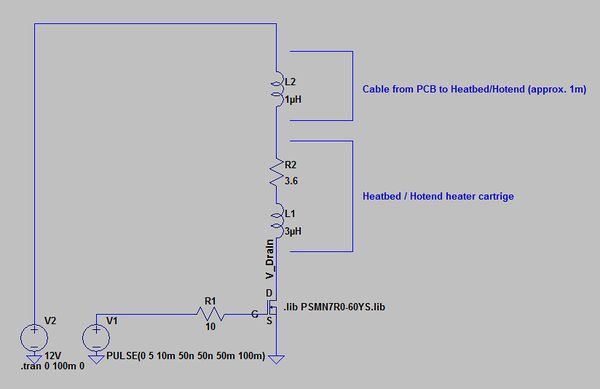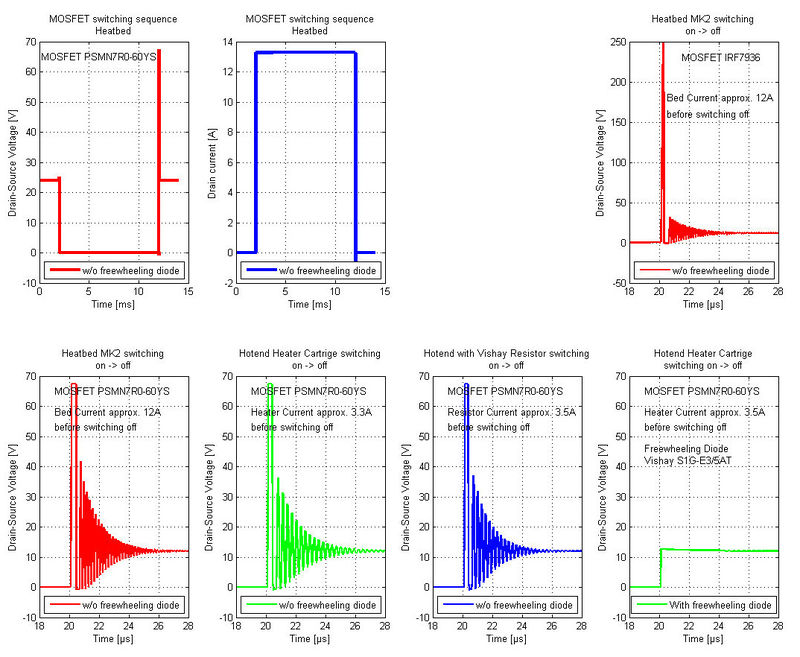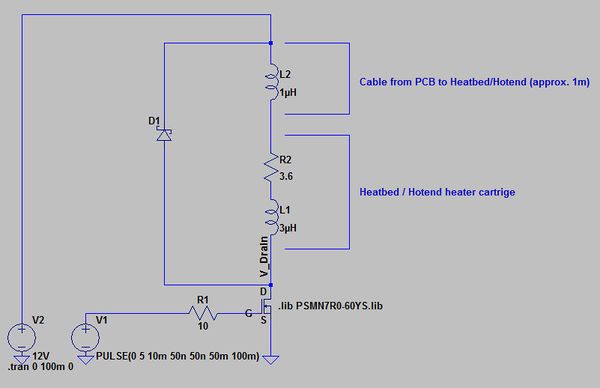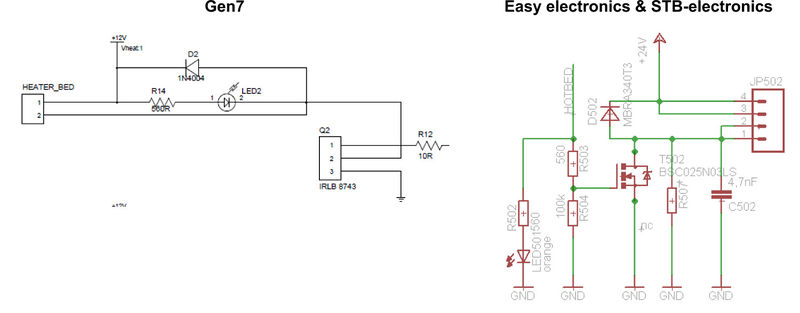Basics about switching loads with MOSFETs/ru
|
English • العربية • български • català • čeština • Deutsch • Ελληνικά • español • فارسی • français • hrvatski • magyar • italiano • română • 日本語 • 한국어 • lietuvių • Nederlands • norsk • polski • português • русский • Türkçe • українська • 中文(中国大陆) • 中文(台灣) • עברית • azərbaycanca • |
В процессе перевода
Considerations about circuit dimensioning of low side MOSFET switches for hotend and heated bed, like they're found in most RepRap electronics designs.
Очень часто пользователи сталкиваются с проблемами с выходами на нагреватели стола или нагреватели экструдеров. Тому есть несколько причин. Основной проблемой является то, что RDS_on используемых транзисторов, с затвором управляемым 5В, слишком мало. Другая проблема заключается в воздействии обратного напряжения на транзистор при его закрытии, что приводит к выходу транзистора из строя. Это обратное напряжение возникает вследствии паразитной индуктивности нагревателя стола, нагревателя печатающей головки или резисторов. В данной статье попытаемся разобраться в причинах этого.
Contents
- 1 Проблема перегрева МОП-транзисторов.
- 2 Problem of reverse voltage killing the MOSFET device
- 3 Исходные файлы (LTSpice)
- 4 Рекомендуем прочитать
- 5 Терминология
- 6 Контакты
Проблема перегрева МОП-транзисторов.
Некоторые вычисления
Дано:
Мощность нагревателя стола 150W @ 12V -> Ток нагревателя 12.5A
Пусть он будет постоянно включен (без использования ШИМ).
Пример 1
МОП-транзисторы от Sanguinololu 1.3a
- RDS_on примерно 40мОм @ Vgs = 5В (сопротивление перехода в открытом состоянии (5В на затворе))
- Package thermal resistance 80°K/W (this means with 1W thermal power loss the package heats up by 80°K) without additional heat spreader.
-> Thermal power loss of the MOSFET device: 12.5A² * 40mOhm = 6.25W -> Theoretical resulting device case temperature 6.25W * 80°K/W + 25°C (ambient temp.) = 525°C
This definitely kills the MOSFET to survive add a heat spreader with at least 15°K/W which results in a device temperature of approx. 120°C at room temperature.
Пример 2
МОП-транзисторы от RUMBA
- RDS_on примерно 10мом @ Vgs = 5В
- Package thermal resistance incl. PCB area approx. 40°K/W
-> Thermal power loss of the MOSFET device 12.5A² * 10mOhm = 1.6W -> Theoretical resulting device case temperature 1.6W * 40°K/W + 25°C (ambient temp.) = 90°C
The device will survive.
Problem of reverse voltage killing the MOSFET device
Some Simulations to show the influence of these parasitics
Typical parasitic inductances:
- Heatbed MK2 650nH
- Vishay 3.3 Ohms power resistor 2µH
- Heater cartrige 12V 40W 3µH
- 1 meter cable 1mm AWG18 1µH (rule of thumb)
(1-3 source: posting Hardwarekiller)
Simulations (LTSpice)
Simulation schematic without freewheeling diode
Simulation results
The two diagrams on the top left shows a single switching sequence from heatbed off - on - off
The leftmost shows the voltage, the picture next to this the Drain current.
You can see that the highest voltages occur when switching from on state to off state.
All other pictures show a zoomed view of the drain-source voltage (Vds) at this event.
You can see that in the top rightmost diagram a voltage of approx. 250V(!) volts occures at the drain of the IRF7936. The device is rated only with 30V Vds. This voltage applys only 100ns and will not kill the device instantaneous but over time this overvoltage will lead to malfunction of the device.
The leftmost three diagrams in the second row show the Vds voltage for the PSMN7R0-60YS MOSFET used on RUMBA in different applications: Heated bed, Hotend with 40W heater cartrige and Hotend with Vishay heater resistor.
As you can see the Vds voltage is approx. 68V. The MOSFET device (PSMN7R0-60YS) is only rated at 60V. This is also out of the specification of the device. Sooner or later it will result in malfunction of the board.
Only the rightmost diagram in the second row shows a Vds voltage which has no critical overshoot
What is the reason for this excellent behaviour? The circuit is using a freewheeling diode across the load (heatbed, hotend) which prevents the voltage overshoot. The schematics below shows the (simple) circuit change.
Simulation schematic with freewheeling diode
Теперь о плохих новостях....
Большинство доступных контроллеров 3Д принтеров не имеют шунтирующих диодов! Я нашел только три доступных контроллера, которые используют их.
Some Examples from on the market available Electronic Boards
Designs examples which lacks MOSFET protection
RUMBA, RAMPS, Sanguinololu & Melzi have no diode and are from this point of view they do not protect the MOSFET from overvoltage peaks.
Designs examples with MOSFET protection
Gen7, easy electronics, STB_Electronics have the diode and prevent the MOSFET from overvoltage peaks.
More examples can be found for good and also for bad circuit design, the examples above are used for reference.
Designer hints for selecting the right MOSFET
- Consult the schematics of the electronics you intend to buy. Compare them to the examples shown in this report and decide what to built or buy.
- Always look for the RDS_on @ Vgs=5V most Devices are specified at Vgs=10V this makes a big difference in terms of RDS_on which is in this case (Vgs=10V) significantly higer at 5V Vgs.
- Make sure that the allowed max. Vds is lager than your power supply voltage.
- Use a freewheeling diode across the load. The requirements on that diode are not very high. The current through this diode is < 5A for approx. 0.5ms. For example a simple 1N4001 diode can make the job. Its allowed forward currend is 30A(!) when the pulse time is below 8ms.
Исходные файлы (LTSpice)
Рекомендуем прочитать
- Gen7 Research with an measurement based approach to the matter (chapter 1 & 2).
- Most stepper motor driver and other motor driver use MOSFETs.
- Most heated bed and Hot End electronics use MOSFETs.
Терминология
- RDS_on resistance of the MOSFET when switched on. Usually in the region of several milliohms
- Vgs voltage applied to the gate of the MOSFET referenced to the source pin. In our application the source pin is tied to GND(ground). This is the control vopltage coming from the µController output
- Vds is the votage measured between drain and source of the MOSFET. This voltage must not be higher than specified in the datasheet. Typical values for MOSFETs used for hotend and heatbed are between 20..60V
- Freewheeling diode (шунтирующий диод). Обратно включенный диод (катод соединён с + и анод с - ) к нагрузке (Нагревательный стол/нагреватель экструдера)
- Diode forward current (прямой ток диода). Ток, протекающий от анода к катоду диода




